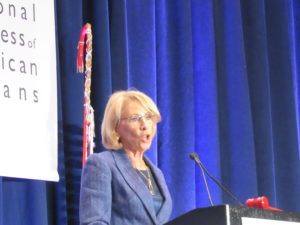
- Details
- By Native News Online Staff
Senators Say the Dept. of Education Miscounts Students in at Least Two Ways
WASHINGTON — Concerned about undercounting of American Indian and Alaska Native students in schools across the country, U.S. Sens.
Tina Smith (D-MN) and Lisa Murkowski (R-AK) sent Education Secretary Betsy DeVos a letter addressing the issue and stressing the importance of securing an accurate count.
 U.S. Dept. of Education Secretary Betsy DeVos
U.S. Dept. of Education Secretary Betsy DeVos
addressing National Congress of American Indians
in Washington, D.C. last week.
Photo by Levi Rickert
In the letter, Smith and Murkowski, both members of the Senate Indian Affairs and Education Committees, told DeVos that inaccurately identifying Native students leads to an incomplete picture of whether or not a school is adequately meeting students’ educational needs.
“Reliable student demographic data is necessary not only to ensure compliance with federal education and civil rights laws that relate to school accountability, but also to build a public education system where every student has access to a quality education that can bring a lifetime of opportunity,” they wrote. “Additionally, accurately identifying AIAN students in public schools is an essential component in fulfilling our nation’s treaty and trust obligations to sovereign Tribal nations.”
The senators cite the Dept. of Education’s guidance and standards for the collection, aggregation and reporting of student race and ethnicity data that results in a significant undercounting of American Indian and Alaska Native students at the federal level—especially for American Indian and Alaska Native students from multiethnic or multiracial backgrounds.
The Senators claim that undercounting of AIAN students using the current DOE guidance occurs in at least two ways.
The letter provided an example of disparity between data collected by the U.S. Department of Education and two state of educations:
“For example, the U.S. Department of Education’s guidance resulted in identification of fewer than 15,000 AIAN students in Minnesota during the 2018-2019 academic year. However, the Minnesota Department of Education, which utilizes more detailed data collection standards than the federal government, identified 23,000 AIAN K-12 students enrolled in the state during that same school year. In Anchorage, Alaska, the federal method identified 4,284 AIAN students using the Department’s guidance, whereas a locally used method that includes AIAN students reported in the ‘Two or more races’ category resulted in 9,073 students.”
At the conclusion of the letter, the senators asked the Department of Education to provide the answers to questions below by February 20, 2020:
- Is the Department aware of the undercounting of AIAN students under its current guidance? And, if so, what steps (if any) has the Department taken to mitigate these problems?
- Has the Department conducted any consultation with Indian Tribes on this issue?
- Since your confirmation as Secretary, what actions or communication (if any) have occurred or are occurring between the Department and OMB related to the standards on race and ethnicity data collection, aggregation, and reporting?
In addition to Sens. Smith and Murkowski, the letter was signed by Sens. Tom Udall (D-N.M.), Tammy Baldwin (D-Wis.), Jacky Rosen (D-Nv.), Elizabeth Warren (D-Mass.) and Jon Tester (D-Mont.).
Text of the letter is available here and below:
The Honorable Betsy DeVos
Secretary of Education
U.S. Department of Education
400 Maryland Ave, SW
Washington, DC 20202
Dear Secretary DeVos,
We write regarding the Department of Education’s current guidance on the collection, aggregation, and reporting of student race and ethnicity data. Specifically, we have concerns related to the impacts of this guidance on American Indian and Alaska Native (AIAN) students and the schools they attend.
Reliable student demographic data is necessary not only to ensure compliance with federal education and civil rights laws that relate to school accountability, but also to build a public education system where every student has access to a quality education that can bring a lifetime of opportunity. Additionally, accurately identifying AIAN students in public schools is an essential component in fulfilling our nation’s treaty and trust obligations to sovereign Tribal nations.
As you are aware, the Department last issued guidance on collecting and aggregating student race and ethnicity data in 2007. This guidance sets forth standards for educational institutions that aligned with the 1997 standards from the Office of Management and Budget (OMB). The standards use a “two-question” format to collect student race and ethnicity data. In question one, respondents are asked if they are Hispanic/Latino. In question two, respondents are asked about their race, including if they are AIAN.
Unfortunately, the Department’s guidance and standards for the collection, aggregation, and reporting of student race and ethnicity data are causing a significant undercounting of AIAN students at the federal level – especially for AIAN students from multiethnic or multiracial backgrounds.
Undercounting of AIAN students using the current Department guidance occurs in at least two ways. First, a respondent who answers “yes” to being Hispanic/Latino is only reported as Hispanic/Latino, even if they indicate that they are AIAN in question two. Second, if a non-Hispanic respondent selects more than one race in question two (e.g. White and AIAN), they are only reported as “Two or more races”.[3] Consequently, the Department’s guidance results in the exclusion of thousands of students who identify as AIAN, including some Tribally enrolled students, in local, state, or federal disaggregated AIAN student data.
For example, the U.S. Department of Education’s guidance resulted in identification of fewer than 15,000 AIAN students in Minnesota during the 2018-2019 academic year. However, the Minnesota Department of Education, which utilizes more detailed data collection standards than the federal government, identified 23,000 AIAN K-12 students enrolled in the state during that same school year. In Anchorage, Alaska, the federal method identified 4,284 AIAN students using the Department’s guidance, whereas a locally used method that includes AIAN students reported in the “Two or more races” category resulted in 9,073 students.
As you know, disaggregated student race and ethnicity data play a crucial role in federal education policy. The Elementary and Secondary Education Act (ESEA), as amended by the Every Student Succeeds Act, mandates that state academic assessment results be disaggregated “by each major racial and ethnic group” for reporting and school accountability purposes. Therefore, these inaccuracies in identifying AIAN students has led to an incomplete picture of whether or not a school, local education agency, or state education agency is adequately meeting these students’ educational needs.
As our nation’s youth and K-12 student population becomes more diverse, including an increasing number of students with multiracial and multiethnic backgrounds it is essential that the methods we use to collect student information yield accurate and useful data.
Accordingly, we respectfully request answers to the following questions by February 20, 2020.
- Is the Department aware of the undercounting of AIAN students under its current guidance? And, if so, what steps (if any) has the Department taken to mitigate these problems?
- Has the Department conducted any consultation with Indian Tribes on this issue?
- Since your confirmation as Secretary, what actions or communication (if any) have occurred or are occurring between the Department and OMB related to the standards on race and ethnicity data collection, aggregation, and reporting?
We look forward to hearing from you and working with you on this important matter.
Sincerely,
More Stories Like This
Native News Weekly (August 25, 2024): D.C. BriefsUS Presidents in Their Own Words Concerning American Indians
Monday Morning: (January 5, 2026): Articles You May Have Missed This Past Weekend
Native News Weekly (January 4, 2026): D.C. Briefs
What Native American Members of Congress Are Saying about the Venezuela Operation
Help us defend tribal sovereignty.
At Native News Online, our mission is rooted in telling the stories that strengthen sovereignty and uplift Indigenous voices — not just at year’s end, but every single day.
Because of your generosity last year, we were able to keep our reporters on the ground in tribal communities, at national gatherings and in the halls of Congress — covering the issues that matter most to Indian Country: sovereignty, culture, education, health and economic opportunity.
That support sustained us through a tough year in 2025. Now, as we look to the year ahead, we need your help right now to ensure warrior journalism remains strong — reporting that defends tribal sovereignty, amplifies Native truth, and holds power accountable.
 The stakes couldn't be higher. Your support keeps Native voices heard, Native stories told and Native sovereignty defended.
The stakes couldn't be higher. Your support keeps Native voices heard, Native stories told and Native sovereignty defended.
Stand with Warrior Journalism today.
Levi Rickert (Potawatomi), Editor & Publisher

